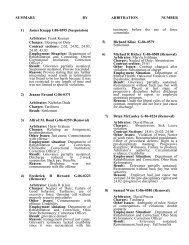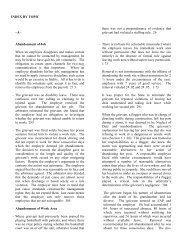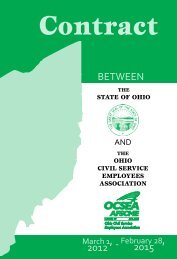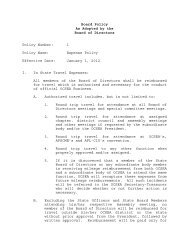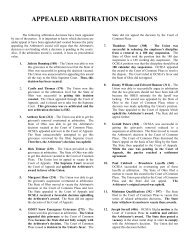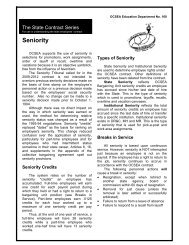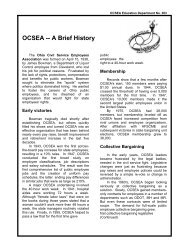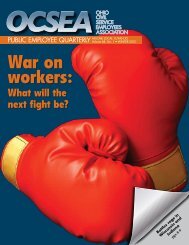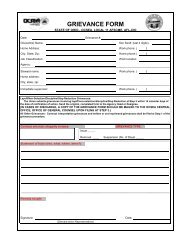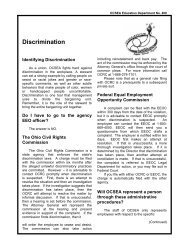by Contract Number (PDF) - OCSEA
by Contract Number (PDF) - OCSEA
by Contract Number (PDF) - OCSEA
Create successful ePaper yourself
Turn your PDF publications into a flip-book with our unique Google optimized e-Paper software.
judgment and his less than credible performance<br />
on the witness stand. The primary reason for his<br />
reinstatement is that the Grievant never intended<br />
to harm the Youth. The Grievant was reinstated<br />
under very strict conditions: he was entitled to<br />
no back pay or other benefits during the period<br />
of his separation, and he was reinstated pursuant<br />
to a two-year probationary plan, under which he<br />
shall violate no rule or policy involving any<br />
youth. Failure to comply will be grounds to<br />
remove the Grievant. 995<br />
The Arbitrator relied on the video evidence. The<br />
video indicated that the youth was not engaged<br />
in any conduct that required imminent<br />
intervention <strong>by</strong> the Grievant. The Arbitrator<br />
held that, given the seriousness of the use of<br />
unwarranted force <strong>by</strong> the Grievant and his failure<br />
to follow proper procedures when judgment<br />
indicated that a planned use of force was<br />
required, just cause for discipline existed.<br />
However, removal was inappropriate. The<br />
Grievant’s record of fourteen years of good<br />
service as well as his reputation of being a<br />
valued employee in helping diffuse potential<br />
problem situations mitigated against his removal.<br />
The incident was hopefully an isolated, one-time<br />
event in the Grievant’s career. 996<br />
The Arbitrator found that the Grievant should<br />
have been aware of Rule 26. He held that there<br />
was no disparate treatment. The choice of the<br />
charge of the Grievant was reasonable and quite<br />
distinguishable from the facts concerning another<br />
corrections officer. The record contained<br />
evidence of evasion <strong>by</strong> the Grievant as to the<br />
reason why he did not report his arrest<br />
immediately. Any violation of Rule 26 would<br />
have been the first offense <strong>by</strong> this Grievant of<br />
Rule 26 and, as such, the maximum sanction for<br />
the first offense is a 2-day fine, suspension, or<br />
working suspension. However, there was a last<br />
chance agreement signed <strong>by</strong> the Grievant, the<br />
warden, and <strong>by</strong> a union representative. The<br />
Arbitrator was limited <strong>by</strong> the rules which the<br />
Grievant accepted in the last chance agreement;<br />
therefore, the Arbitrator has no authority to<br />
modify the discipline in this case. Rule 26, an<br />
SOEC Rule on the performance track of the<br />
disciplinary grid, was violated <strong>by</strong> the Grievant.<br />
Once such a finding is made, the Grievant<br />
himself agreed in the last chance agreement “that<br />
the appropriate discipline shall be termination<br />
from (his) position.” 998<br />
The Arbitrator found that the evidence showed<br />
the Grievant had violated Work Rule Neglect of<br />
Duty (d) and Failure of Good Behavior (e). The<br />
evidence failed to demonstrate any words or<br />
conduct that rose to the level of a threat or<br />
menacing. The Arbitrator held that the removal<br />
was excessive due to the Grievant’s medical<br />
condition; the Grievant’s acute personal issues; a<br />
relatively minor discipline record at time of<br />
removal; eleven years of satisfactory service; and<br />
the absence of threatening conduct. The<br />
Arbitrator reinstated the Grievant with<br />
conditions: she will successfully complete an<br />
EAP program for anger management and<br />
stress—failure to do so would be grounds for<br />
immediate removal; discipline of a 15 day<br />
suspension without pay for violating the work<br />
rules; she shall receive no back pay, senority<br />
and/ or any other economic benefit she may have<br />
been entitlted to; she shall enter into a Last<br />
Chance Agreement, providing that any<br />
subsequent violation of the work rules for a year<br />
following her reinstatement will result in<br />
immediate removal. 999<br />
The Arbitrator found that from approximately<br />
1995 until 2006 the Employer did not investigate<br />
relationships and/or other improprieties<br />
involving gifts or money received <strong>by</strong> employees<br />
from residents. The Arbitrator cited a 2007<br />
decision: “Arbitrator Murphy found that the<br />
Employer’s lax enforcement of its policies ‘. . .<br />
lulled the employees into a sense of toleration <strong>by</strong><br />
the Employer of acts that would otherwise be a<br />
violation of policy.’” There was no evidence<br />
that the Employer made any efforts to put its<br />
employees on notice that certain<br />
policies/procedures which were previously<br />
unenforced would no longer be ignored. The<br />
Arbitrator noted that statements made <strong>by</strong> the<br />
Grievant and her co-workers indicated<br />
evasiveness, but not falsification. The Arbitrator<br />
held that just cause did not support the decision<br />
to suspend the Grievant for ten (10) days.<br />
Furthermore, the Grievant’s failure to report any<br />
information under Policy No. 4 prior to<br />
November, 2006 occurred in an environment<br />
indicating that relationships or the exchange of<br />
items of value was known and tolerated <strong>by</strong> OVH<br />
Management. 1001<br />
Central to the issue was the credibility of the<br />
Grievant. There wasevidence to contradict the<br />
Grievant’s statement that the youth threatened to<br />
harm himself. Reliable evidence existed to



